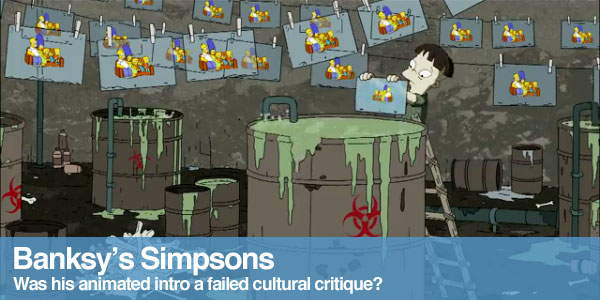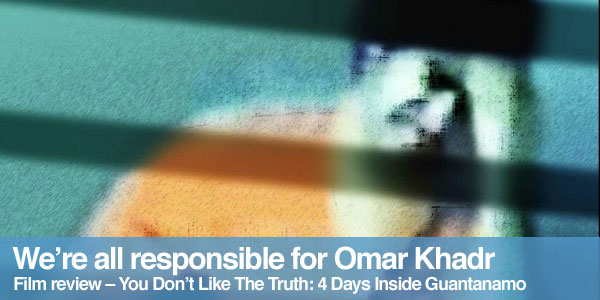Friday Film Pick: Khadr's lawyer Dennis Edney gives a moving speech in Montreal
by Ezra Winton on October 29, 2010 · View Comments
This week’s FFP is more of a clip than a “film” per se. But we have two solid reasons for selecting it. We’re releasing this footage of Omar Khadr’s lawyer giving his very moving speech to a small crowd at Montreal’s Festival du Nouveau Cinema on October 14, 2010, following the premiere screening of You Don’t Like the Truth: 4 Days Inside Guantanamo. We posted a review of this incredible documentary here on Art Threat some days ago and the response from our readers has been overwhelming and positive, so we thought you might appreciate this speech.
The second reason is that Khadr is in the news right now with recent reports of his apology to American Sgt Speer’s widow, who the CBC reports “was killed by Khadr’s grenade.” Although ALL evidence points to the contrary of the events Khadr has admitted to, even if we assume they are true, then he was a child soldier when they happened and needs to be released from the US and sent home to Canada immediately, then released from prison. We want to show that we aren’t forgetting about the context of this case and the injustices that have befallen Khadr via the US and Canadian governments.
You may want to turn up your volume, the audio is a little low.
 City of Borders opens with Boody, a young gay Palestinian, climbing a fence to sneak into Israel. “We’re not going to do bombs, we’re not going to do anything wrong,” he tells the camera. “We only go to have to have fun, live our life.” Once over the fence, he and his friends go to Shushan, the only gay bar in Jerusalem. Adam, an atheist Israeli, soon joins him, as well as lesbian couple Samira, an Israeli Palestinian, and Ravit, a Jewish Israeli.
City of Borders opens with Boody, a young gay Palestinian, climbing a fence to sneak into Israel. “We’re not going to do bombs, we’re not going to do anything wrong,” he tells the camera. “We only go to have to have fun, live our life.” Once over the fence, he and his friends go to Shushan, the only gay bar in Jerusalem. Adam, an atheist Israeli, soon joins him, as well as lesbian couple Samira, an Israeli Palestinian, and Ravit, a Jewish Israeli.
Shushan is a place where gay and straight, Arab and Israeli peacefully coexist for the purpose of having a good time. The acceptance of the bar has opened the eyes of many. One of the Israeli patrons explained that Shushan made him realize everything he thought was based on hate. “I kissed an Arab,” he exclaimed. “This place allowed that kiss to happen.”
Click to continue »

Anthony Freda’s illustrations may be familiar to you. They’ve shown up in Time and The New Yorker, in the Rolling Stone and Esquire and Playboy, and more ‘serious’ publications like Business Week and The New York Times. His work at once speaks to contemporary issues of America at war, problems of patriotism, and harkens to earlier decades in which we’ve struggled with the same issues. His work is immediately accessible to any kind of viewer, even those who may not want to consider the deeper messaging. Being the art dork I am I wanted to know first about why he chose to speak to issues this way, and then about why he chose those issues in particular.
Amanda: Let’s start by talking about the physical objects, what media do you use to make these illustrations and what draws you to them?
Click to continue »
In commemoration of recent BDS against Israel (Boycott, Divestment, Sanctions) actions, events and conferences throughout the world, including Montreal where John Greyson spoke, we bring you this great little ditty by Greyson and friends. In his talk, Greyson (an activist, professor, writer and filmmaker) spoke of the incessant “brain worms” that crawl around our consciousness and repeat pop hooks and rhythms we’ve heard in music, for better or worse.
On the more toxic side is the tune-appropriation by the eleven Israeli journalists who ripped the “We are the World” song and sang, posing as the flotilla members murdered only the day before, “We Con the World.” The racist music video went viral and before you knew it, many of us were walking around with “We Con the World” echoing in our heads (including yours truly). Greyson argues that the progressive politicos need to start engineering more of these brain worms, and the above video, “Vuvuzela” is a provocation to do just that. From Elton to Bjork to Diana Krall – they cover the match in a play-by-play of artists who support the BDS campaign and those who do not. More of Greyson and friends’ works can be found on his Vimeo channel.

Ok so, this isn’t exactly political, but I’m into it. Today is, apparently, Drop Everything and Read Day in British Columbia! At 11am put down whatever you’re doing, pick up a book or magazine or a newspaper and do some reading. Hopefully you’re here at Art Threat, reading one of the interesting things from our great writers!
In Secrets of Success, a Radiolab episode from this past July, Jad and Robert interview Malcolm Gladwell (of the Tipping Point, Blink, and Outliers fame) who claims that “if one child learns to read at four, and one child learns to read at two and a half, so what? why does it matter? Are the things that are being read between two and four of such incalculable importance … reading is reading, once you can read, you’re done. It’s not like there’s an infinite scale, and someone can read better and better.”
Click to continue »
In light of recent news coverage of the many young queer victims of bullying, ridicule and oppression, this week’s pick is the 2008 one hour National Film Board of Canada documentary Cure for Love, directed by Francine Pelletier and Christina Willings.
Here’s the synopsis from the NFB site: “Cure for Love is a full-length documentary about a controversial evangelical movement that purports to convert gay people into heterosexuals. The film brings us inside this unusual Christian subculture and follows the lives of several young people whose homosexuality is at odds with their religious beliefs.” Thankfully, curing gay-bashing is something we can hope for in the future – and maybe even religious chauvinism too.
 Last week, I posted about a woman who walked into the Loveland Museum/Gallery and destroyed a piece of artwork by Enrique Chagoya. I questioned at the end of my article whether critiques with the weight and emotional volume of Chagoya’s print – which depicted Jesus in sexual acts (a Christian favourite) and an Islamic prophet kneeling before pigs, among other things.
Last week, I posted about a woman who walked into the Loveland Museum/Gallery and destroyed a piece of artwork by Enrique Chagoya. I questioned at the end of my article whether critiques with the weight and emotional volume of Chagoya’s print – which depicted Jesus in sexual acts (a Christian favourite) and an Islamic prophet kneeling before pigs, among other things.
Under normal circumstances, the immoral act of destroying ones art would likely make an artist completely irate. Chagoya, however, has agreed to work with the pastor of Loveland’s Resurrection Fellowship church to create a piece of artwork depicting Jesus in a positive light. Pastor Jonathan Wiggins wrote Chagoya after opposition to the artwork began asking if Chagoya would be able to “offer [his] artistic ability and compose an image of Christ representing love and understanding, something precious.”
Click to continue »







 Last week, I posted about a woman who walked into the Loveland Museum/Gallery and
Last week, I posted about a woman who walked into the Loveland Museum/Gallery and








